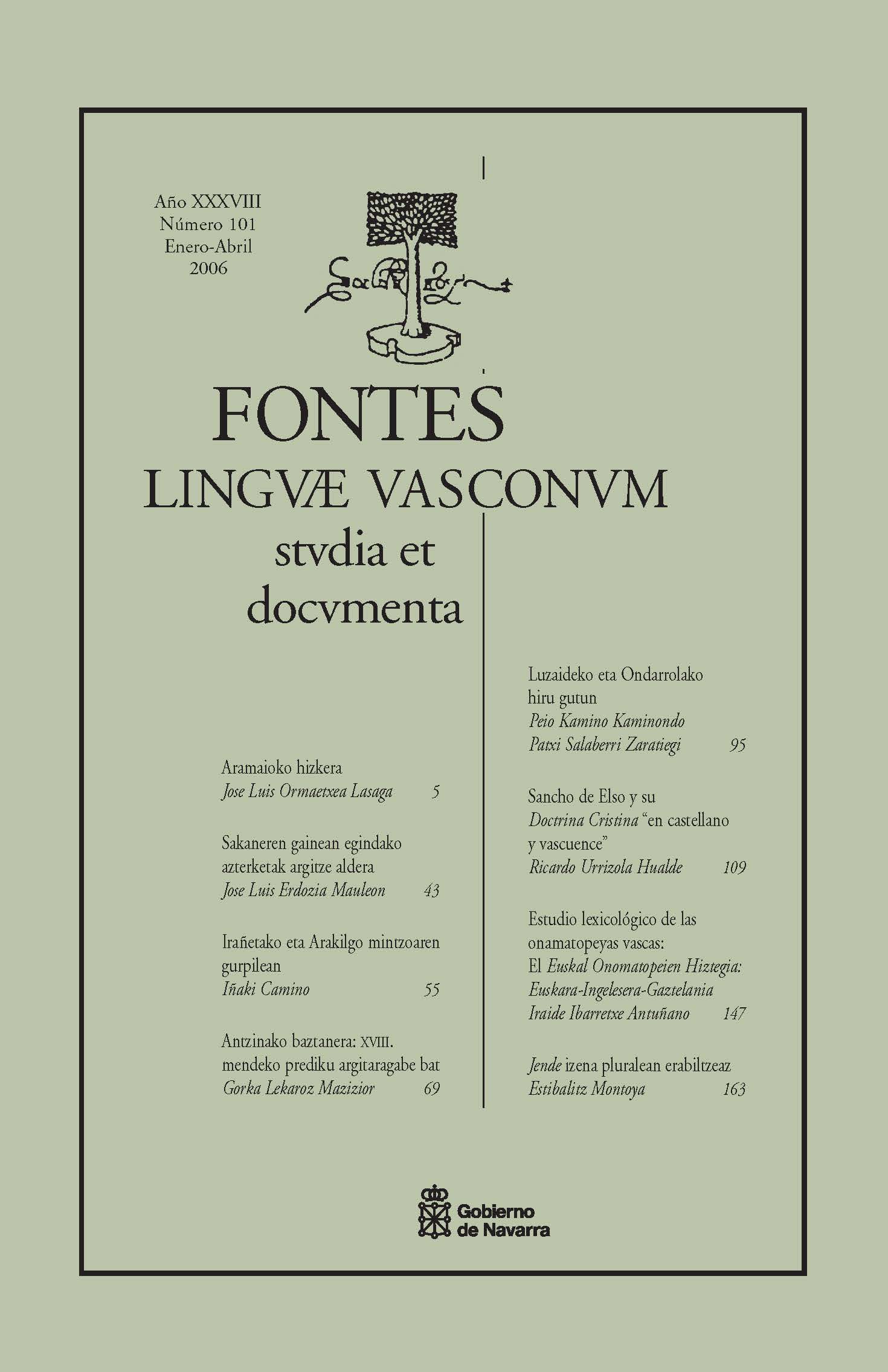Estudio lexicológico de las onomatopeyas vascas: El Euskal Onomatopeien Hiztegia: Euskara-Ingelesera Gaztelania
Abstract
Onomatopoeia is the word used in Basque lexicology to describe those words in which there exists a more or less direct relationship between sound and meaning. In this article, we describe the lexicographical work performed in order to draft a trilingual dictionary of Basque onomatopoeias, the Euskal Onomatopeien Hiztegia: Euskara-Ingelesera-Gaztelania (Ibarretxe-Antuñano 2006) and the reasons which led to its creation. Despite the importance of onomatopoeias in the lexicon of this language, some Basque authors defining them as the carriers of primitive Basque culture (Lecuona 1964), studies systematically collecting the great lexical wealth of the Basque language had previously been carried out, bar a few word lists in a limited number of publications (Azkue 1923-25; Zamarripa 1987).The creation of this dictionary is a first step towards the recognition of these words in Basque studies. The article is organised as follows: Section 1 is a brief overview of the place occupied by onomatopoeias in linguistic studies and the reasons why they occupy such a place; Section 2 deals with the steps taken in order to create this dictionary; and Section 3 describes the structural, morphosyntactic and morphosemantic characteristics of Basque onomatopoeias. The conclusion then indicates the possible applications and limitations of a dictionary of this kind.
##about.statistics##
References
ALLOTT, R., 1995, "Sound symbolism", Language in the Würm Glaciation, Eds. U.L. Figge. Bochum: Brockmeyer, 15-38.
DIFFLOTH, G., 1972, "Notes on expressive meaning", Papers from the Regional Meeting of the Chicago Linguistics Society, 8, 440-447.
DOKE, C.M., 1935, Bantu Linguistic Terminology, Londres, Longman, Green and Co.
CHILDS, G.T., 1994, "African ideophones", Studies in Sound Symbolism, Eds. L. Hinton, J. Nichols y J. Ohala, Cambridge, Cambridge University Press, 247-279.
CHILDS, G.T., 1998, "Ideophone variation is tied to local identity", The Sociolinguistics of Language and Society: Selected Papers from SS IX, Ed. M.K. Verma, Londres, Sage, 36-46.
CHILDS, G.T., 2001, "Research on ideophones, whither hence?", Ideophones, Eds. F.K.E. Voeltz y C. Kilian-Hatz, Amsterdam y Filadelfia, John Benjamins, 63-73. https://doi.org/10.1075/tsl.44.06chi
CHILDS, G.T., 2003, An Introduction to African Languages, Amsterdam y Filadelfia, John Benjamins. https://doi.org/10.1075/z.121
ETXEPARE, R., 2003, "Valency and argument structure in the Basque verb", A Grammar of Basque, Eds. J. I. Hualde y J. Ortiz de Urbina, Amsterdam y Filadelfia, John Benjamins, 363-425. https://doi.org/10.1515/9783110895285.363
GARCÍA DE DIEGO, V., 1968, Diccionario de voces naturales, Madrid, Aguilar.
GRAMMONT, M., 1933, Traité de phonétique, Paris.
HAMANO, S., 1998, The Sound-Symbolic System of Japanese, Stanford, CLSI Publications.
HINTON, L. NICHOLS, J. y J. OHALA, 1994, Sound Symbolism, Cambridge, Cambridge University Press. https://doi.org/10.1017/CBO9780511751806
HIROSE, M., 1981, Japanese and English Contrastive Lexicography: The Role of Japanese 'Mimetic Adverbs', PhD Dissertation, University of California.
HUALDE, J. I., 1991, Basque Phonology, Londres y Nueva York, Routledge.
HUALDE, J. I., J. A. LAKARRA, y R.L. TRASK (eds.), 1995, Towards a History of Basque Language, Amsterdam y Filadelfia, John Benjamins. https://doi.org/10.1075/cilt.131
HUALDE, J. I., y J. ORTIZ DE URBINA, 2003, A Grammar of Basque, Amsterdam y Filadelfia, John Benjamins. https://doi.org/10.1515/9783110895285
IBARRETXE-ANTUÑANO, I., 2005, "Lexicalisation patterns and sound symbolism in Basque", comunicación presentada en el Congreso Internacional New Directions in Cognitive Linguistics. First UK Cognitive Linguistics Conference, University of Sussex, 23-25 octubre 2005.
IBARRETXE-ANTUÑANO, I., 2006a, Euskal onomatopeien hiztegia. Euskara-Ingelesera-Gaztelania [Diccionario de onomatopeyas vascas. Euskara-Inglés-Español], Donostia, Gaiak.
IBARRETXE-ANTUÑANO, I., 2006b, Sound Symbolism and Motion in Basque, Munich, Lincom Europa.
JENDRASCHEK, G., 2002, Semantische Eigenschaften von Ideophonen im Türkischen, Munich, Lincom Europa.
DE JONG, N., 2001, "The ideophone in Didinga", Ideophones, Eds. F.K.E. Voeltz y C. KilianHatz, Amsterdam y Filadelfia, John Benjamins, 120-138. https://doi.org/10.1075/tsl.44.11jon
KAKEHI, H., I. TAMORI y L. SCHOURUP, 1996, Dictionary of Iconic Expressions in Japanese, Berlin y Nueva York, Mouton de Gruyter. https://doi.org/10.1515/9783110809046
KITA, S., 1997, "Two-dimensional semantic analysis of Japanese mimetics", Linguistics, 35, 379-415. https://doi.org/10.1515/ling.1997.35.2.379
LECUONA, M., 1964, Literatura oral vasca, Donostia, Auñamendi.
MAGNUS, M., 1999, Gods of the Word: Archetypes in the consonants, Kirksville, Thomas Jefferson University Press.
MICHELENA, L., 1985, Fonética Histórica Vasca, Donostia, Gipuzkoako Foru Aldundia.
NEWMEYER, F., 1993, "Iconicity and generative grammar", Language, 68, 756-796. https://doi.org/10.1353/lan.1992.0047
ONO, S., 1994, A Practical Guide to Japanese-English Onomatopeya and Mimesis, Tokio, Hokuseido.
SAMARIN, W. J., 1970, "Inventory and choice in expressive language", Word, 26.2, 153-169. https://doi.org/10.1080/00437956.1970.11435590
SAMARIN, W. J., 1971, "Survey of Bantu ideophones", African Language Studies, 12, 130-168.
SAUSSURE, F., de, 1916, Cours de Linguistique Générale, ed. by Charles Bally, Albert Sechehaye y Albert Riedlinger, Lausanne, Payot. Traducción al español M. Armiño, 1989, Curso de Lingüística General, Madrid, Akal.
TRASK, R. L., 1997, The History of Basque, Londres y Nueva York, Routledge.
ULLMAN, S., 1972, Semantics. An Introduction to the Science of Meaning, Oxford, Blackwell.
VOELTZ, F. K. E. y C. KILIAN-HATZ, 2001, Ideophones, Amsterdam y Filadelfia, John Benjamins https://doi.org/10.1075/tsl.44
Copyright (c) 2006 Iraide Ibarretxe Antuñano

This work is licensed under a Creative Commons Attribution-NonCommercial 4.0 International License.







